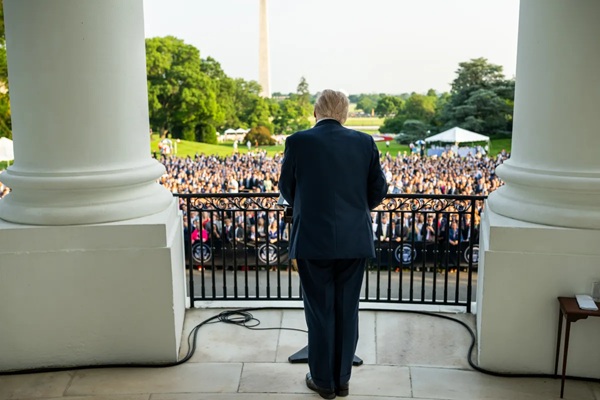.png)
America's National Security for Sale
The message to US adversaries is clear: America’s national security has been subordinated to the Trump administration’s narrow financial or partisan interests. The sale has begun. Come bearing money, political favors, or both.


Aziz Huq, Professor of Law at the University of Chicago, is the author of The Collapse of Constitutional Remedies.
August 12, 2025 at 2:27 PM IST
Perhaps the least interesting thing about the reported decision by US President Donald Trump’s administration to allow Nvidia and AMD to export high-end semiconductors to China in exchange for 15% of the revenues is that it is probably unlawful. More important is the window it opens onto how the presidency is using its national security powers not to advance the country’s interests, but for its own, narrower ambitions.
To understand what’s at stake, consider Nvidia’s H20 chips, which Trump, when justifying his decision, described as an “old chip” that is “obsolete.” In 2024, Nvidia sold about a million of these “obsolete” H20s in China. This is about five times the number of similar chips sold by Huawei. The scale of Nvidia’s advantage suggests that H20 chips, while no longer cutting edge, remain very valuable to Chinese firms. Nvidia’s CUDA programming interface makes them easier to connect to other hardware than Huawei’s products.
Overwhelming evidence of H20 chips’ continuing relevance came in January, when the Chinese firm DeepSeek used them to develop a breakthrough large language model delivering top-of-the-line performance without the price tag of OpenAI, Anthropic, or Google models. Such semiconductors thus still play a pivotal role in the ongoing competition between China and the United States over AI, such that permitting their export undermines rather than advances US interests.
China has growing access to all the other inputs to create new AI. Its universities, unlike the leading US institutions under attack from Trump, can still recruit and educate top-flight scientific talent. It has ample data, energy, and even a near-monopoly on rare-earth minerals used to build the AI “stack.” But the gap between Nvidia’s and Huawei’s market share suggests that access to advanced chips (including H20s) remains a significant vulnerability. Earlier this year, RAND identified export controls on chips as the most potent lever to shape China’s AI development path.
This explains the Trump administration’s decision in April, three months after DeepSeek’s release, to impose a new licensing requirement on H20 chips, with a presumption of denial. But now the White House has relinquished that lever without extracting any concessions from Chinese firms or Chinese authorities.
And the US needs concessions from China. Consider that China controls 70% of the world’s rare-earth minerals, which are needed for many digital tools. Major gaps in US military supply chains that could have been addressed by striking a deal will remain unfilled. Items like the heat-resistant magnets needed for missiles, fighter-jets, and smart bombs will remain in dangerously short supply. At a time of growing investment in military deployments in the Indo-Pacific that require these very tools, US trade policy seems to be cannibalizing US security policy.
The Nvidia and AMD export deal, in short, is an unforced error. So, what motivated the decision?
The president’s authority to control exports of so-called dual-use goods (which can serve both civilian and military purposes), such as advanced semiconductors, stems from the 2018 Export Control Reform Act. The government is allowed to require “licenses” for certain exports, while also “imposing conditions or restrictions” on those licenses.
No doubt, the government will claim that its 15% tax is a “condition.” But the 2018 law sets out an exemplary list of “conditions.” All concern how and by whom a technology can be used or shared. The list strongly suggests that Congress did not delegate its inherent power to impose taxes to the president in that law. Just as the 1977 International Emergency Economic Powers Act cannot fairly be read to create a secret power to tax imports, as Trump’s tariffs do, so, too, the Export Control Reform Act does not create a secret power to tax exports.
One way to understand the Nvidia/AMD deal is by comparing it to this administration’s other policies, and finding patterns. Perhaps the closest parallel is the administration’s treatment of the social media platform TikTok. Having tried to ban the platform during his first term on national-security grounds, Trump came into office under a statutory mandate to prohibit it unless its Chinese owners divested. In January 2025, the Supreme Court upheld the ban, which Trump postponed. The statute allowed a single 90-day delay, but only with a buyer on the horizon. Having blown past this deadline, Trump has simply refused to enforce a valid law that aligns with his own erstwhile position on national security.
In both the TikTok case and the Nvidia/AMD deal, Trump violated a federal statute by allowing transactions with Chinese entities – transactions the same administration once described as a source of serious security concerns. In both cases, this was done without a deal or negotiation to achieve a public-policy goal.
But in the TikTok case, Trump was clear about his motives: TikTok, he thinks, helped him win the “youth” in the 2024 election. National security considerations, that is, gave way to electoral advantage. The Nvidia/AMD deal offers similar advantages: A recent Congressional Budget Office estimate suggests that Trump’s budget will increase the national deficit by $4.1 trillion. Squeezing money from tech firms can be framed as a political win, and as a deficit offset, even though the revenue will be a mere drop in the bucket.
Even better for Trump, because there is no statute that envisages revenue from export controls, there is no legal constraint on how the government uses them. Trump could, say, use the money for the White House’s new ballroom, or it could construct more “Alligator Alcatraz” prisons for undocumented immigrants.
The message to US adversaries is clear: America’s national security has been subordinated to the Trump administration’s narrow financial or partisan interests. The sale has begun. Come bearing money, political favors, or both.
© Project Syndicate 1995–2025



